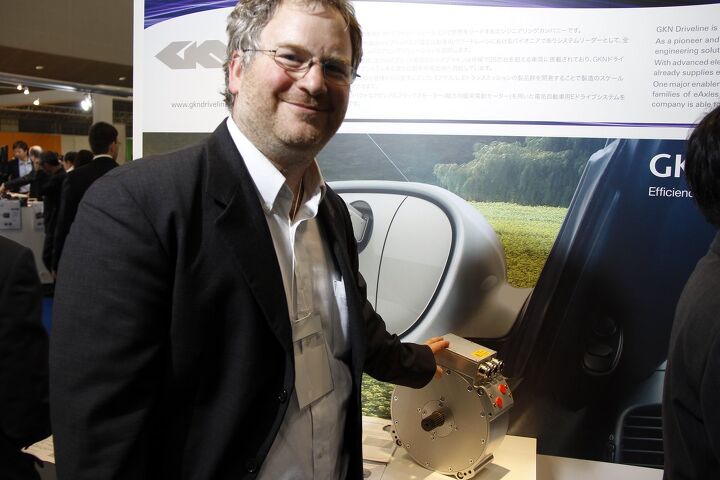Swiss Inventor Explains The EMERG-E Engine, And Why He Has Something Better

Walking across the exhibition floor of the annual conference of the Japan chapter of the SAE, one gets the impression that the internal combustion engine is an endangered species.
Nearly everything that is on display here is battery operated. The few ICEs on display are either big diesel holdouts from UD Trucks, or the flat four of the Hachi-Roku. Just about anything else is electric in one way or the other.
In a corner, a man demonstrates the engine that will be in the Infiniti EMERG-E mid-engined range extended electric sports car if it ever gets built.
Dr. Michael Lamperth is a Swiss mechanical engineer. He moved to England, where he taught at the Imperial College for 10 years before founding EVO Electric. Fashionably located at the former headquarters of McLaren, the company builds electric motors and generators based on axial flux technology.
Asked to explain what powers the Lotus Evora 414E Hybrid and the Infiniti EMERG-E, Lamperth gives it short shrift: “The car has two times two electric motors. Together they produce 400kW, everything in a light package. They get their juice from a battery, the battery is range extended with an ICE.” Then, he wants to talk about something else.
The true church of EVs demands either pure battery, or a range extender, but Lamperth is not convinced:
“I think series/parallel is much better. On the highway, there is nothing better than a diesel engine that powers the wheels directly. This is more efficient than even fuel cells.”
Lamperth thinks it is wasteful to convert fuel into mechanical power, which creates electricity, which then powers an engine.
Instead, Lamperth is pushing his DuoDrive. The drive consists of a generator and an electric motor, mated through a clutch. It replaces the transmission. In a London Taxi, it was a straight swap.
On the freeway, the ICE powers the wheels. If needed, it receives assistance from the electric motor.
In the city, the car runs on battery as long as there is a charge. EVO has a patent on a system that uses axial flux engines, but Lamperth concedes that the series/parallel principle has been there before. “It’s the holy grail of the business.”
Looks are deceiving. The ICE will power the car for a long time. Maybe, through a more efficient transmission.

Bertel Schmitt comes back to journalism after taking a 35 year break in advertising and marketing. He ran and owned advertising agencies in Duesseldorf, Germany, and New York City. Volkswagen A.G. was Bertel's most important corporate account. Schmitt's advertising and marketing career touched many corners of the industry with a special focus on automotive products and services. Since 2004, he lives in Japan and China with his wife <a href="http://www.tomokoandbertel.com"> Tomoko </a>. Bertel Schmitt is a founding board member of the <a href="http://www.offshoresuperseries.com"> Offshore Super Series </a>, an American offshore powerboat racing organization. He is co-owner of the racing team Typhoon.
More by Bertel Schmitt
Latest Car Reviews
Read moreLatest Product Reviews
Read moreRecent Comments
- MaintenanceCosts This is probably as good as B5.5's get, but keeping it that way is going to be very very expensive, and for all that money you won't even have three pedals.
- Urlik Peak Passat.
- Cla65786503 Do the esses at Riverside International Raceway count as a corner?
- El scotto Do the Agnellis care about any of this?
- El scotto Wait! What are these higher-level Kias you write about?






































Comments
Join the conversation
If only Honda can put a clutch between ICE output shaft and the IMA motor… Closing all the valves when in EV mode is not enough.
I understand that "bridge" technologies have to exist, but we need more EV thinkers that don't have the "easy out" of ICE - think of Iran closing the Strait of Hormuz, or the loss of a major Saudi oil facility. In other words, think of $10/Gal fuel, and then get back to me about that ICE stuff. We need to get our day-to-day commutes off of oil (and save it for the intercity diesel trucks and air travel for commerce) so if bad things happen overseas, we are more independent and our economy won't collapse. This is a question of national security, not a silly game.